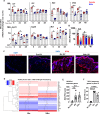The early local and systemic Type I interferon responses to ultraviolet B light exposure are cGAS dependent
- PMID: 32404939
- PMCID: PMC7220927
- DOI: 10.1038/s41598-020-64865-w
The early local and systemic Type I interferon responses to ultraviolet B light exposure are cGAS dependent
Abstract
Most systemic lupus erythematosus (SLE) patients are photosensitive and ultraviolet B light (UVB) exposure worsens cutaneous disease and precipitates systemic flares of disease. The pathogenic link between skin disease and systemic exacerbations in SLE remains elusive. In an acute model of UVB-triggered inflammation, we observed that a single UV exposure triggered a striking IFN-I signature not only in the skin, but also in the blood and kidneys. The early IFN-I signature was significantly higher in female compared to male mice. The early IFN-I response in the skin was almost entirely, and in the blood partly, dependent on the presence of cGAS, as was skin inflammatory cell infiltration. Inhibition of cGAMP hydrolysis augmented the UVB-triggered IFN-I response. UVB skin exposure leads to cGAS-activation and both local and systemic IFN-I signature and could contribute to acute flares of disease in susceptible subjects such as patients with SLE.
Conflict of interest statement
The authors declare no competing interests.
Figures






References
Publication types
MeSH terms
Substances
Grants and funding
LinkOut - more resources
Full Text Sources
Other Literature Sources
Molecular Biology Databases

